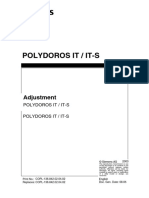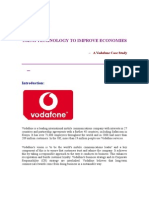The Analysis & Forecasting of British Cycling Time Trial Records
The Analysis & Forecasting of British Cycling Time Trial Records
Uploaded by
CristianLopezCopyright:
Available Formats
The Analysis & Forecasting of British Cycling Time Trial Records
The Analysis & Forecasting of British Cycling Time Trial Records
Uploaded by
CristianLopezOriginal Title
Copyright
Available Formats
Share this document
Did you find this document useful?
Is this content inappropriate?
Copyright:
Available Formats
The Analysis & Forecasting of British Cycling Time Trial Records
The Analysis & Forecasting of British Cycling Time Trial Records
Uploaded by
CristianLopezCopyright:
Available Formats
2nd World Congress of Cycling Science, 2nd and 3rd July 2014, Leeds
BOOK OF ABSTRACTS
J Sci Cycling. Vol. 3(2), 8
Open Access
The analysis & forecasting of British cycling
time trial records
BTJ Dyer , H Hossani and M Shadi
1
Abstract
Background: The sport of cycling time trials in Great Britain has taken place over several distance or time based
formats since 1935. The format of this sport typically involves riders competing individually over several fixed race
distances of 10-100 miles in length or using time constrained formats of 12 and 24 hours in duration. The aim of the
sport is to cover the fixed race distance or duration at the highest possible speed. Each of these events has its own
national record. A new record can be established and ratified at any point of the year when achieved in an event of
the same race length.
Purpose: An evaluation of British cycling time trials over a maximum period of 80 years may provide some insight
into the progression of the sports records and what performances may be possible by athletes in the future.
Methods: The progression of time trial records across six events were plotted and reviewed. This data was obtained
from the sports governing body website and annual handbook. The fixed distances that were investigated were the
10, 25, 50 and 100 mile distances. In addition, the 12 hour and 24 hour fixed duration events were also analysed. To
determine forecasts for each records future progression, the Singular Spectrum Analysis (SSA) technique was
applied to the historical record data. This time series analysis technique has not been applied to sports-based data
to date.
Results: The data from all 6 events typically follows a non-linear progression of performance. Excluding the relatively
recent introduction of the 10 mile distance, the five other datasets all saw a high frequency of new records being
established from 1950-1969 and a reduction in the frequency after this. Conversely, since 1970 these records have
indicated a larger percentage improvement when they have occurred. The SSA technique provided forecasts using
a line of best fit with a minimum of 99% goodness of fit for all six datasets. The SSA forecasts projected that by
2030, the records would stand as 16:51 (10 miles), 41:48 (25 miles), 1:27:40 (50 miles), 3:03:57 (100 miles), 323.76
miles (12 hour) and 550.937 miles (24 hour).
Discussion: The non-linear nature of the records is typical of the characteristics recorded in other endurance sports
over long term time periods. However, to achieve the SSA forecasts, these would then require substantial
improvements in a riders physiological power output and/or reductions in their aerodynamic drag. However, cycling
time trials have historically also been subjected to the influence of sociological factors such as traffic flow, weather
and favorable course design. As a result, such targets may well be assisted by the impact or development of positive
factors outside of the riders control. Further research into the impact of traffic drafting and course topographies may
well provide further evidence to reinforce the projections successfully modeled here.
Conclusion: A review of six British cycling time trial records generally demonstrated a decreasing frequency of
attainment but larger margins of improvement over time. Further improvements in performance were forecasted with
a high percentage of line fit using the Singular Spectrum Analysis technique. These forecasts provide challenging
targets and would require a combination of favorable improvements in physiological power generation, reductions in
total aerodynamic drag and other conditions outside of the riders direct control.
Contact email: brdyer@bournemouth.ac.uk
(BTJ. Dyer)
Bournemouth University, Faculty of Science & Technology. United
Kingdom
2
Bournemouth University, The Business School. United Kingdom
__________________________________________________
Received: 1 May 2014. Accepted: 1 June 2014.
2014 2nd World Congress of Cycling Science, 2nd and 3rd July 2014, Leedst; licensee JSC. This is an Open Access article distributed under the
terms of the Creative Commons Attribution License (http://creativecommons.org/licenses/by/3.0/), which permits unrestricted use, distribution, and
reproduction in any medium, provided the original work is properly cited.
You might also like
- Spot Speed StudyDocument8 pagesSpot Speed StudyMuhammad AimiNo ratings yet
- Polydoros It / It-S Polydoros It / It-SDocument10 pagesPolydoros It / It-S Polydoros It / It-SMario Rodríguez100% (1)
- Global Positioning Systems (GPS) and Microtechnology Sensors in Team Sports: A Systematic ReviewDocument19 pagesGlobal Positioning Systems (GPS) and Microtechnology Sensors in Team Sports: A Systematic Reviewbiciusas the coachNo ratings yet
- SSRN Id1618806Document22 pagesSSRN Id1618806nugraha dendiNo ratings yet
- 2022-Running Your Best Triathlon RaceDocument4 pages2022-Running Your Best Triathlon RaceMARCELO RAYMUNDONo ratings yet
- Pacing in Long-Distance Running Sex and Age Differences in 10-Km Race and MarathonDocument11 pagesPacing in Long-Distance Running Sex and Age Differences in 10-Km Race and MarathonnetosallesNo ratings yet
- Sports: Reliability of The Single-Visit Field Test of Critical Speed in Trained and Untrained AdolescentsDocument11 pagesSports: Reliability of The Single-Visit Field Test of Critical Speed in Trained and Untrained AdolescentsJúnior Alvacir CamargoNo ratings yet
- 78 532 1 PBDocument5 pages78 532 1 PBCristianLopezNo ratings yet
- Training Intensity Distribuition Analysis by Race Pace Vs Physiological Approach in World-Class Middle - and Long-Distance RunnersDocument24 pagesTraining Intensity Distribuition Analysis by Race Pace Vs Physiological Approach in World-Class Middle - and Long-Distance Runnersgines.gonzalez.umhNo ratings yet
- Fuel ProcessDocument13 pagesFuel Processpapareza100% (1)
- File From iOSDocument8 pagesFile From iOSPiotrNo ratings yet
- Lab Report Spot Speed StudyDocument12 pagesLab Report Spot Speed Studyazrulamri1980yahoocom0% (1)
- Highton Et Al. (2012)Document8 pagesHighton Et Al. (2012)Callum BromleyNo ratings yet
- Getting It Right: Edestrian Ehicle OllisionsDocument63 pagesGetting It Right: Edestrian Ehicle OllisionsPetar OsijekNo ratings yet
- Computational Intelligence and Neuroscience - 2022 - Yuan - Factor Analysis and Regression Prediction Model of SwimmersDocument9 pagesComputational Intelligence and Neuroscience - 2022 - Yuan - Factor Analysis and Regression Prediction Model of Swimmers4ryfulNo ratings yet
- Johns Et Al 2023 Analysis of The Competition Programmes of Elite and Sub Elite Swimmers The Influence of Sex Stroke andDocument10 pagesJohns Et Al 2023 Analysis of The Competition Programmes of Elite and Sub Elite Swimmers The Influence of Sex Stroke andyogiarnaldoputra06No ratings yet
- The Relationship Between Running Power and RunningDocument10 pagesThe Relationship Between Running Power and RunningDario GerpeNo ratings yet
- Applications of GPS Technologies To Field Sports, Aughey (2011)Document17 pagesApplications of GPS Technologies To Field Sports, Aughey (2011)john lewisNo ratings yet
- HM Art 38656-10Document7 pagesHM Art 38656-10陈韦杰No ratings yet
- Paper Westera DummyDocument17 pagesPaper Westera DummyPilarRubioFernándezNo ratings yet
- Bishop Et Al., (2019d)Document10 pagesBishop Et Al., (2019d)oliveira orlandi juniorNo ratings yet
- GPS in CricketDocument14 pagesGPS in CricketsagarNo ratings yet
- 2020 - Even pacing is associated with faster finishing times in ultramarathon distance trail running.....Document11 pages2020 - Even pacing is associated with faster finishing times in ultramarathon distance trail running.....natachvsNo ratings yet
- Barnesetal 2014Document7 pagesBarnesetal 2014Ionel ColonelNo ratings yet
- Modelling of Critical Power From Road DataDocument2 pagesModelling of Critical Power From Road DataCristianLopezNo ratings yet
- Pacing Strategy and Tactical Positioning During Cyclo-Cross RacesDocument7 pagesPacing Strategy and Tactical Positioning During Cyclo-Cross RacesAMBAR SOFIA SOTONo ratings yet
- Malone Et Al 2019 - To Infinity and Beyond - The Use of Gps Devices Within The Football CodesDocument10 pagesMalone Et Al 2019 - To Infinity and Beyond - The Use of Gps Devices Within The Football CodesFernando AmuNo ratings yet
- Cin2022 2052975Document9 pagesCin2022 20529754ryfulNo ratings yet
- Kinem 100Document12 pagesKinem 100nachox_99No ratings yet
- 1-s2.0-S0965856423002549-mainDocument18 pages1-s2.0-S0965856423002549-mainRichter Opoku - BoahenNo ratings yet
- Barnesetal2014Document7 pagesBarnesetal2014Aymen NouadriNo ratings yet
- Bicycle Tracks and Lanes: A Before-After Study: January 2008Document16 pagesBicycle Tracks and Lanes: A Before-After Study: January 2008RazvanMolieNo ratings yet
- Step Frequency Patterns of Elite Ultramarathon Runners During A 100-km Road RaceDocument7 pagesStep Frequency Patterns of Elite Ultramarathon Runners During A 100-km Road RaceVagner Ferreira CassolaNo ratings yet
- Capacity and Behaviour On One Way Cycle Tracks o 2016 Transportation ResearcDocument15 pagesCapacity and Behaviour On One Way Cycle Tracks o 2016 Transportation ResearcAllassane DOUMBIANo ratings yet
- (2014) Applied Physiology of Female SoccerDocument24 pages(2014) Applied Physiology of Female SoccerDario GerpeNo ratings yet
- The Effect of Posted Speed Limit On The DispersionDocument15 pagesThe Effect of Posted Speed Limit On The DispersionutsavgNo ratings yet
- Age at Peak Performance of Successful Track and Field AthletesDocument14 pagesAge at Peak Performance of Successful Track and Field AthletesChristine BrooksNo ratings yet
- Over Ground Running Speed For Inertial SensorsDocument6 pagesOver Ground Running Speed For Inertial SensorsrashslashNo ratings yet
- Repeated Dribbling Ability in Young Soccer Players OKDocument13 pagesRepeated Dribbling Ability in Young Soccer Players OKGiuseppe ScervinoNo ratings yet
- Training Periodization Intensity Distribution and Volume in Trained Cyclists: A Systematic ReviewDocument12 pagesTraining Periodization Intensity Distribution and Volume in Trained Cyclists: A Systematic ReviewMiguel Angel Galán RiojaNo ratings yet
- Accepted: Mechanisms For Improved Running Economy in Beginner RunnersDocument27 pagesAccepted: Mechanisms For Improved Running Economy in Beginner RunnersmadloloNo ratings yet
- A Decline in Anaerobic Distance Capacity of Champion Athletes Over The Years?Document9 pagesA Decline in Anaerobic Distance Capacity of Champion Athletes Over The Years?Fansisca SiallaganNo ratings yet
- Barnesetal 2014Document7 pagesBarnesetal 2014bvgqptkhshNo ratings yet
- Speed Spot StudiesDocument16 pagesSpeed Spot StudiesLuqman YusofNo ratings yet
- The Evolution of Physical and Technical PerformanceDocument7 pagesThe Evolution of Physical and Technical Performanceoliveravictor133No ratings yet
- Speeding Up or Slowing Down Analysis of Race Results in Elite Level Swimming From 2011 2019 To Predict Future Olympic Games PerformancesDocument12 pagesSpeeding Up or Slowing Down Analysis of Race Results in Elite Level Swimming From 2011 2019 To Predict Future Olympic Games PerformancesHusan ThapaNo ratings yet
- Oliva-Lozano 2020 Analisis de Variables en TemporadaDocument30 pagesOliva-Lozano 2020 Analisis de Variables en Temporadapedro.coleffNo ratings yet
- A Brief Description of The Biomechanics and Physiology of A Strongman Event: The Tire FlipDocument26 pagesA Brief Description of The Biomechanics and Physiology of A Strongman Event: The Tire FlipMamedNo ratings yet
- Moir Et Al 2017 - Mechanical Limitations To Sprinting and Biomechanical Solutions A Constraints-Led Framework For The Incorporation of Resistance Training To Develop Sprinting SpeedDocument40 pagesMoir Et Al 2017 - Mechanical Limitations To Sprinting and Biomechanical Solutions A Constraints-Led Framework For The Incorporation of Resistance Training To Develop Sprinting SpeedMarko TrofenikNo ratings yet
- 2010 Speed StudyDocument64 pages2010 Speed StudyDistrict Department of TransportationNo ratings yet
- A Novel Field Test To Determine Critical SpeedDocument5 pagesA Novel Field Test To Determine Critical SpeedpremtimNo ratings yet
- Design Speed, Operating Speed, and Posted Speed Limit Practices PDFDocument20 pagesDesign Speed, Operating Speed, and Posted Speed Limit Practices PDFBasil50% (2)
- CPM 5gpsDocument2 pagesCPM 5gpsTayyab RahmanNo ratings yet
- 10 3389@fphys 2019 00375Document24 pages10 3389@fphys 2019 00375scribd4freeNo ratings yet
- Analysis of The Performance Indices in Urban Sprint Orienteering in Relation To The Performance in Track RunningDocument5 pagesAnalysis of The Performance Indices in Urban Sprint Orienteering in Relation To The Performance in Track RunningSavio SoaresNo ratings yet
- The Training Characteristics of World-Class Distance Runners: An Integration of Scientific Literature and Results-Proven PracticeDocument18 pagesThe Training Characteristics of World-Class Distance Runners: An Integration of Scientific Literature and Results-Proven PracticeSportsciencesNo ratings yet
- Calzado en CorredoresDocument11 pagesCalzado en CorredoresJosé MeléndezNo ratings yet
- 10 1 1 657 7385 PDFDocument31 pages10 1 1 657 7385 PDFmaorpeNo ratings yet
- Art 92Document9 pagesArt 92coloumbetNo ratings yet
- Guellich Training Rowers IJSPP2009Document14 pagesGuellich Training Rowers IJSPP2009Le Xuan Mai 21510101424No ratings yet
- Scientific Integrity and Ethics in the GeosciencesFrom EverandScientific Integrity and Ethics in the GeosciencesLinda C. GundersenNo ratings yet
- 44 - 2WCSCDocument1 page44 - 2WCSCCristianLopezNo ratings yet
- The Effect of Wheel Diameter On Vertical and Horizontal Mountain Bike PositionDocument1 pageThe Effect of Wheel Diameter On Vertical and Horizontal Mountain Bike PositionCristianLopezNo ratings yet
- 41 - 2WCSCDocument1 page41 - 2WCSCCristianLopezNo ratings yet
- Comparing Time-Trial and Time To Exhaustion Performance: Book of AbstractsDocument1 pageComparing Time-Trial and Time To Exhaustion Performance: Book of AbstractsCristianLopezNo ratings yet
- Effects of A Seven Day Period of High-Intensity Training On Performance and Physiology of Competitive CyclistsDocument1 pageEffects of A Seven Day Period of High-Intensity Training On Performance and Physiology of Competitive CyclistsCristianLopezNo ratings yet
- Effect of Environmental Temperature On Pacing During A Simulated 16 KM Cycling Time TrialDocument1 pageEffect of Environmental Temperature On Pacing During A Simulated 16 KM Cycling Time TrialCristianLopezNo ratings yet
- Do 3-Min All-Out Test Parameters Accurately Predict Competitive Cyclist Performance in The Severe Intensity Domain?Document1 pageDo 3-Min All-Out Test Parameters Accurately Predict Competitive Cyclist Performance in The Severe Intensity Domain?CristianLopezNo ratings yet
- Relation Between Lactic Acid Steady-State and Muscle Oxygenation in Elite CyclistsDocument3 pagesRelation Between Lactic Acid Steady-State and Muscle Oxygenation in Elite CyclistsCristianLopezNo ratings yet
- 35 - 2WCSCDocument1 page35 - 2WCSCCristianLopezNo ratings yet
- 26 - 2WCSCDocument1 page26 - 2WCSCCristianLopezNo ratings yet
- 20 - 2WCSCDocument1 page20 - 2WCSCCristianLopezNo ratings yet
- Past Attempts To Identify A Single Physiological Parameter As The Main Indicator of Success in The Tour de France Seem To Have FailedDocument2 pagesPast Attempts To Identify A Single Physiological Parameter As The Main Indicator of Success in The Tour de France Seem To Have FailedCristianLopezNo ratings yet
- Modelling of Critical Power From Road DataDocument2 pagesModelling of Critical Power From Road DataCristianLopezNo ratings yet
- Gross Efficiency Is Improved in Standing Position With An Increase of The Power OutputDocument1 pageGross Efficiency Is Improved in Standing Position With An Increase of The Power OutputCristianLopezNo ratings yet
- Measures of Training Stress in Cyclists Do Not Usefully Predict Maximum Mean Power in CompetitionsDocument1 pageMeasures of Training Stress in Cyclists Do Not Usefully Predict Maximum Mean Power in CompetitionsCristianLopezNo ratings yet
- Individualised Training Duration Induces Similar Physiological and Performance Benefits at Different IntensitiesDocument1 pageIndividualised Training Duration Induces Similar Physiological and Performance Benefits at Different IntensitiesCristianLopezNo ratings yet
- Relationship Between Leg Length and Trunk Orientation in CyclingDocument1 pageRelationship Between Leg Length and Trunk Orientation in CyclingCristianLopezNo ratings yet
- Flange 150#Document5 pagesFlange 150#Ashok KumarNo ratings yet
- On The Hydrolytic Stability of Polyester YarnsDocument12 pagesOn The Hydrolytic Stability of Polyester YarnsAnnie LauNo ratings yet
- A Vodafone Case StudyDocument7 pagesA Vodafone Case StudyAnjani RajNo ratings yet
- Amazing Stories Volume 12 Number 03Document126 pagesAmazing Stories Volume 12 Number 032close2theflame100% (1)
- ACY2021 2020 - 21 S1 Individual Assignment (Question Paper)Document3 pagesACY2021 2020 - 21 S1 Individual Assignment (Question Paper)ali razaNo ratings yet
- The Mediation Effect of Job Satisfaction and Organizational Commitment On The Organizational Learning Effect of The Employee PerformanceDocument27 pagesThe Mediation Effect of Job Satisfaction and Organizational Commitment On The Organizational Learning Effect of The Employee PerformanceNely Noer SofwatiNo ratings yet
- Standing Order - Labour LawDocument39 pagesStanding Order - Labour LawArunVermaNo ratings yet
- Chapter 2Document42 pagesChapter 2Cherry Joyce PatalNo ratings yet
- Chapter 6Document26 pagesChapter 6Almira, Maria amor100% (1)
- AO Trauma Asia Pacific Course Calendar 2024Document7 pagesAO Trauma Asia Pacific Course Calendar 2024prajwal guptaNo ratings yet
- Company Profile GGC ICTDocument33 pagesCompany Profile GGC ICTSamehNo ratings yet
- Couns Interview Rating Form CIRF SamDocument4 pagesCouns Interview Rating Form CIRF Samkarmstrong3No ratings yet
- Grade Does Not Define You. You Bukan Telur AyamDocument7 pagesGrade Does Not Define You. You Bukan Telur AyamAinulNo ratings yet
- KTH EI2436 20142 1 enDocument2 pagesKTH EI2436 20142 1 enGIngaaNo ratings yet
- 7 - Ca 80Document2 pages7 - Ca 80Rady CadsNo ratings yet
- 01) Sahil Goyal - FDI IN RETAILDocument7 pages01) Sahil Goyal - FDI IN RETAILpriyankaNo ratings yet
- Baumer BHF ENCODERDocument4 pagesBaumer BHF ENCODERAgus SalimbasukiNo ratings yet
- Okabashi Case StudyDocument5 pagesOkabashi Case StudyBilal AhmedNo ratings yet
- Openstack HPDocument15 pagesOpenstack HPMathavan SundharamoorthyNo ratings yet
- Spectra LR50W Receiver SensorDocument4 pagesSpectra LR50W Receiver Sensorbbutros_317684077100% (1)
- Addl Requirements For Elevated Steel Tank - 2edDocument31 pagesAddl Requirements For Elevated Steel Tank - 2edAnton_Young_1962No ratings yet
- PPTDocument14 pagesPPTDr.Amitkumar RaiNo ratings yet
- P725 Rev 29 Instruction ManualDocument103 pagesP725 Rev 29 Instruction Manualduque_sadeNo ratings yet
- NGFW Site-To-Site VPN Troubleshooting GuideDocument6 pagesNGFW Site-To-Site VPN Troubleshooting GuideBhavik2002No ratings yet
- 2022 HTT451 Topic 3Document25 pages2022 HTT451 Topic 3Hanisah Ma'amorNo ratings yet
- i8008UM Nov 73 PDFDocument132 pagesi8008UM Nov 73 PDFMario SchutzNo ratings yet
- Ieee 664Document23 pagesIeee 664Servando LozanoNo ratings yet
- 9 Speed TransmissionDocument9 pages9 Speed TransmissioniwearnexusNo ratings yet
- Settlements Sociology Economics Culture: Human & Study Of, &Document68 pagesSettlements Sociology Economics Culture: Human & Study Of, &SanjuNo ratings yet









































































































